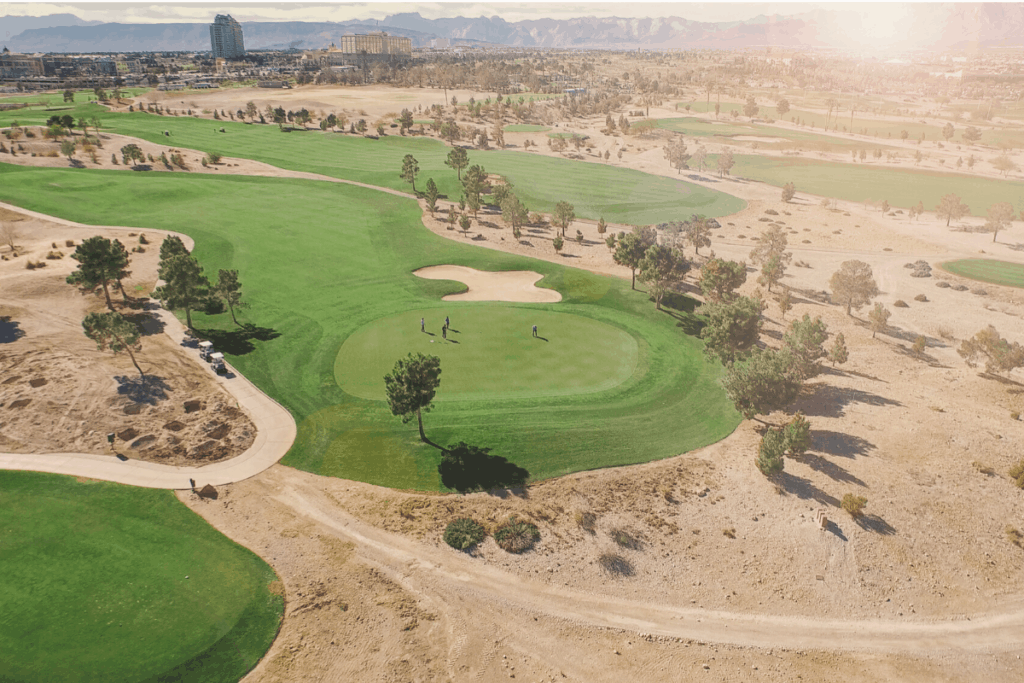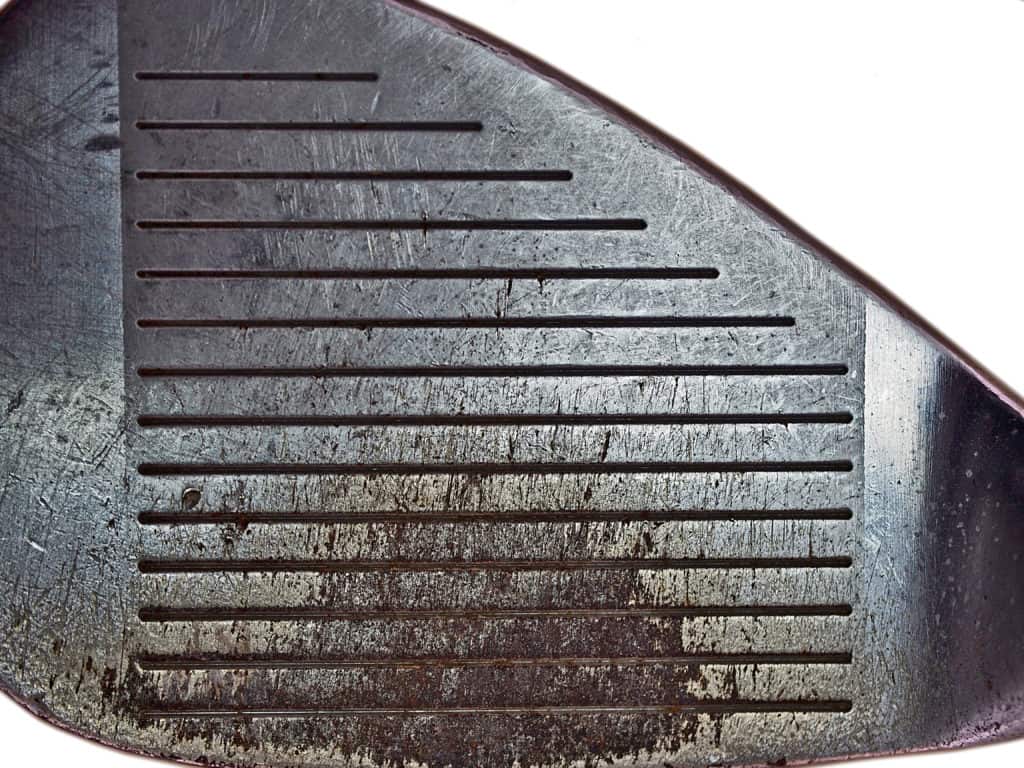If you are heading to a course that has extremely firm greens, a great deal of undulations and difficult pin placements that are within 2-3 yards of the edge, the 64 degree wedge might be the right option for you.
As the greens at golf courses get faster and firmer, some golfers have considered adding a 64 degree lob wedge to their bag.
If you play a course that has plenty of undulations and greenside bunkers, the golfer might want to consider the 64 degree wedge.
The majority of the time a 60 degree lob wedge is enough loft, but there are some special circumstances where a golfer will want to pick the 64 degree wedge to their bag.
When to use a 64 degree wedge?
Personal Experience: All golfers need to experiment around the green and have a game plan for when they will use a 48, 52, 56, 60 or 64 or some club in between. Have a game plan and stick to the plan for several rounds and measure your success rate of hitting quality shots and saving pars. From there you can always adjust your game plan once some data has been collected!
5 Key Situations When To Use a 64 Degree Wedge
- Difficult Course Conditions
- Short Sided Shot
- Difficult Bunker Shot
- Where Plenty of Loft Is Needed
- Out of Thick Rough
Key Situation #1: Difficult Course Conditions
As we talked about above, the course conditions will lead to you adding the 64 degree wedge to your bag. The golfer gets to carry 14 clubs, so pick the clubs wisely and take into consideration the situations you might face on the course.
Once again, the course conditions where there are extremely firm greens, difficult pin placements and plenty of undulations is the time and place to add the 64 degree wedge to the bag.
The firm greens make a course difficult because loft is needed to help the ball stop. If you hit a shot out of the rough with little spin, chances of the ball stopping on a firm green are minimal. Also, many modern courses now have plenty of bunkers, and different peninsula-like areas within their green complexes.
While the golf courses created in the early 1900s and mid 1900s were difficult in their own right, many do not have large green complexes where pins are tucked away behind a bunker. This alone can make a course really difficult.
The golfer is usually left with two options on an approach shot: hit the middle of the green and try to two putt from 30 feet or be more aggressive towards the pin, but risk the short sided shot or the ball left in the bunker.
Oftentimes when playing a tournament or a competitive round at a golf course, the greenskeeper takes pride in putting the hole locations in difficult spots. Be prepared for these difficult pin placements and have a go to club if you short side yourself.
Helpful Post: How to hit a flop shot!

Key Situation #2: Short Sided Shot
If you are trying to shoot a low score that day, you will need to take some risk on your approach shots. Inevitably you will miss a shot and short side yourself. When the course conditions are difficult, having as much loft as possible for the chip/flop shot will be important to saving your par and keeping the round going.
Whether you are playing out of a bunker or thicker rough, a shot with enough loft to help the ball stop will be important. When playing a chip or flop shot a golfer cannot get enough spin to stop the ball and must rely on the loft to help the ball stop quickly.
Being able to open that club up, take a decent size swing and throw it up in the air is a skill that needs practiced, but is easier with the right club. The 64 degree club is the easiest club to hit this shot with for the majority of golfers.
Helpful Post: What degree wedge is best for chipping?
Key Situation #3: Difficult Bunker Shot
If you have ever been in a pot bunker or a bunker that is dug well below the green surface, you understand the importance of having enough loft to throw the ball up onto the green. The extra loft helps the golfer get the ball up and out of the bunker and keeps the golfer from having to hit a 2nd shot from the same bunker.
While it is easy to open a 60 degree wedge and hit a similar shot, some golfers might be better at this shot with the 64 degree wedge. By adding the 64, the golfer now has more options for all of the difficult shots around the green. We must all keep in mind that close to 70% of the shots in a round of golf take place from 100 yards and in from the hole.
Helpful Post: What is the most versatile club?

Key Situation #4: Where Plenty of Loft Is Needed
The 64 degree wedge can be used from shots around 70 yards and in for the golfers with the most speed. Having this option on a fuller shot from further out will be helpful with difficult pin placements or firm greens. The golfer also can close the face down a bit and take some loft off the shot and hit the shot that hops, skips and stops within 2-3 bounces of landing on the green.
The club can become rather versatile with plenty of practice and knowledge on how to use the club. Some golfers prefer taking a fuller swing from close distances and the 64 degree wedge provides that option for the golfer.
Helpful Post: How to spin your wedges
Key Situation #5: Out of Thick Rough
If you have ever played a golf course with really thick rough, you will understand that having enough loft on these shots is vital. Trying to hit a 52 or 54 degree wedge out of thick rough from around the green can be rather difficult.
When all of the factors are added up: firm greens, tough pin locations, major undulations and thick rough the golfer is left with few options other than taking as much loft as possible. Yes, you could select the 56 degree shot and play it safe to 15-20 feet, but then you are really reducing your chance of saving par on the holes where you miss the green.
Helpful Post: How far should I hit my wedges?
Quick Fact: Did you know that the average scrambling rate for the scratch golfer is 54%?
Here is a breakdown of the average stats of a scratch golfer:
| Greens in Regulation | 67% |
| Fairways Hit | 53% |
| Putts Per Hole | 1.67 |
| Scrambling | 54% |
| Sand Saves | 59% |
| Average Driving Distance | 251 |
The bottom line is that the golfer must be able to save par when missing the green around 54% of the time to be close to a scratch golfer. While it will take some solid ball striking to 67% of the greens, it doesn’t take a great deal of speed or power to be an excellent short game player.
It just takes the right equipment, enough practice and then being able to execute the shot on the golf course.

Next Steps
The key next step is to consider what wedges you need for your game. In a typical setup for a golf bag, I would recommend one of two setups below:
- 48 Degree
- 54 Degree
- 60 Degree
Or
- 48 degree
- 52 degree
- 56 degree
- 60 degree
However, if you are playing a really difficult course that day, you might want to consider a 64 degree wedge.
If you are someone that plays competitively I would recommend purchasing the 64 degree wedge and having it as an option depending on the course that you are playing and what the conditions are like.
Helpful Post: How can I improve my distance control?
Take Action – What You Can Do Today to Get Better
What does this mean for you? I believe in the following recipe to get better:
1 – Improve your motion in the golf swing by identifying a golf instructor. Here are some options:
Here is a list of golf instructors that we have reviewed:
2 – Train to swing faster and improve your swing speed. Here are some options:
Looking to gain more Speed and Distance in your swing. Two Options:
3 – Understand course strategy and work to break through your next barrier. Here is a series on breaking through:
We have provided guides on how to break 100, 90, 80 and 70. Check out more below, if interested.
4 – Practice Frequently
Did you know that I build a golf simulator in my garage and have played over 500 rounds of golf on my SkyTrak system? It has been a game changer and one worth checking out. Here are some of my other posts on golf simulators frequently asked questions:
- Is a Golf Simulator Worth It?
- How to Build a Golf Simulator?
- What is the Best Golf Simulator?
- Golf Simulator Accessories?
- How to Build a Golf Simulator for under $7000
- Top 11 Reasons to Buy a SkyTrak
- How to Build a Golf Simulator for Under $1000
- Why Build A Golf Simulator?
- What Space is Needed?
- Can A Golf Simulator Improve My Game?
- How Much Does A Golf Simulator Cost?
- Don’t Forget to Check out our 15 best golf swings of all time.
I am an amateur golfer on a journey to get better, enjoy the game as often as possible and share my passion and knowledge with others. I have coached high school golfers at a high level and have a great passion for the game and want to give back. I enjoy learning about the golf swing and am currently studying to be a certified professional golf instructor. Join me in our journey to get better everyday. Thank you for reading!

